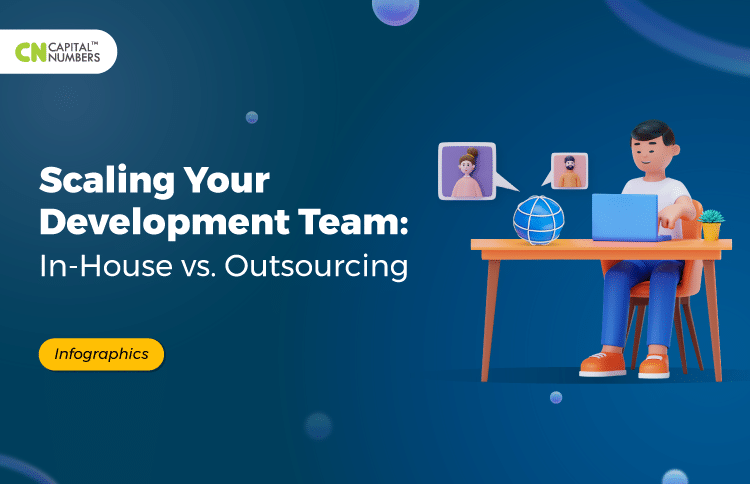Scaling Your Development Team: In-House vs. Outsourcing
Table of Contents
As technology companies continue to thrive in an ever-evolving digital landscape, CTOs face the crucial challenge of scaling their development teams to meet the increasing market demands. The decision to scale the team is pivotal, as it directly impacts the company’s ability to deliver high-quality software solutions efficiently and stay competitive in a fast-paced industry.
Generally, two common approaches come to mind when scaling a development team: scaling in-house by hiring new talent and expanding the existing team or opting for outsourcing by partnering with external software development firms. Each approach has advantages and considerations; understanding them is vital in making an informed decision.
So, the decision to scale your development team should not be taken lightly. It requires careful evaluation, strategic planning, and consideration of several key factors. By exploring these considerations and understanding the nuances of each approach, CTOs can make an informed choice that aligns with their company’s unique needs and sets them on a path to successful growth.
Do you also want to expand your team, so wondering whether to hire web developers or opt for an outsourcing partner? Not to worry!
Here we will discuss both aspects in detail and compare them so that you gain valuable insights that will help you make well-informed decisions and effectively scale your development teams. Let’s dive in!
7 Things that CTOs should do before scaling the development team
If you are planning to scale your development team considering the project needs, you need to focus on these things –
- Define project requirements: Evaluate the scope, timeline, and skills required for your project.
- Assess internal resources: Determine if your in-house team has the necessary skills and capacity.
- Consider budget and cost factors: Evaluate the financial implications of in-house scaling or outsourcing.
- Evaluate time constraints: Consider your project timelines and the need for a faster ramp-up period.
- Assess intellectual property and security concerns: Evaluate the sensitivity of the project and data security requirements.
- Consider long-term strategy: Align the decision with the company’s long-term goals and scalability.
- Seek expert advice and industry insights: Consult experienced professionals for guidance and perspectives.
In-house vs. Outsourcing: Which Approach is a Better Choice for CTOs?
Being a CTO, are you in a dilemma and wondering how to scale your development team? Let’s go through the infographic and the detailed information below to understand the approaches and make an informed decision.

1. Talent pool:
- In-House: When scaling your development team in-house, you are limited to the local talent pool. You need to upgrade your team members’ skills if you need specific domain expertise. Also, you may face challenges finding suitable tech talents with the required skills and expertise. It often requires extensive recruitment efforts. Even after the long and tedious hiring, CTOs often find it challenging to retain developers.
- Outsourcing: On the other hand, outsourcing provides access to a global talent pool. You’ll be spoilt with options with an immense global pool of talent. This allows you to tap into specialized talent and find resources with the specific skills required for your development projects. For example, you can choose an award-winning outsourcing partner like Capital Numbers to easily access India’s top 1% of developers with expertise in web, mobile, software development, design, testing, etc.
2. Recruitment and onboarding
- In-House: Building an in-house development team involves time-consuming recruitment and onboarding. It requires advertising job positions, reviewing applications, conducting multiple rounds of interviews, and finally onboarding the selected candidates. This process can be resource-intensive and may take a significant amount of time.
- Outsourcing: An outsourcing partner like Capital Numbers streamlines recruitment and onboarding. The outsourcing provider takes care of finding and vetting the right professionals for your projects. They handle the hiring process and ensure that the team members are onboarded smoothly, saving you time and effort.
3. Cost and resources
- In-House: Scaling your development team in-house comes with higher costs. You must budget for salaries, benefits, infrastructure, equipment, software licenses, and ongoing operational expenses. These costs can increase quickly, especially when hiring skilled professionals and maintaining a suitable work environment.
- Outsourcing: On the flip, outsourcing offers a cost-effective option for scaling your team. The outsourcing partner manages infrastructure, equipment, and HR needs, reducing overhead costs. Instead of hiring full-time employees, you pay for your outsourcing partner’s services, resulting in potential cost savings. Besides, if you choose a leading partner like Capital Numbers, you can avail of their services at a 50% reduced price.
4. Scalability and flexibility:
- In-House: Some projects require diverse skill sets. And you need the right talent to avoid project constraints. Scaling your in-house team for that can be a time-consuming process. It requires identifying the need for additional resources, going through the recruitment process, and onboarding new team members. Scaling up or down may involve significant time and resources.
- Outsourcing: Outsourcing provides easy scalability. If you need to expand your development team for a specific project, the outsourcing partner can quickly allocate additional resources to meet your requirements. Similarly, you can quickly reduce the team size if you need to scale down after project completion. This flexibility allows you to adapt to changing project demands more efficiently.
5. Expertise and specialization:
- In-House: Building an in-house team may limit your access to specialized skills and expertise. You should invest in additional training or hire new team members with the desired expertise. Acquiring specialized skills can be time-consuming and may delay project timelines.
- Outsourcing: Outsourcing from a company like Capital Numbers gives you access to a wide range of specialized skills and expertise. Your outsourcing partner already has a team of 750+ proficient professionals skilled in various technologies, such as Cloud, Mobile, DevOps, Data Engineering, and Application Development using React, Angular, .NET, Python, Node, PHP, and Java. It enables you to leverage their specialized knowledge without extensive training or hiring efforts.
6. Communication and collaboration:
- In-House: When working with an in-house team, you can communicate and collaborate easily due to proximity. Your team members can interact face-to-face, attend meetings, and share a working environment. This proximity can facilitate quick decision-making and foster a cohesive team culture.
- Outsourcing: Outsourcing requires effective communication strategies and tools to overcome geographical and cultural differences. Remote communication channels, such as video conferences, instant messaging, and project management tools used by companies like Capital Numbers, make collaboration and communication easier. Precise and efficient communication practices need to be established to ensure effective cooperation with the outsourcing team.
7. Risk and control
- In-House: An in-house team gives you more control over the development process. You can closely monitor and manage the team’s activities, ensuring alignment with your project goals and objectives. However, this also means you bear the sole responsibility for the success of the projects and any associated risks.
- Outsourcing: Outsourcing involves sharing the responsibility for project success with your outsourcing partner. While you may have less direct control over the development process, the outsourcing provider is equally invested in delivering high-quality results. Effective project management practices, regular communication, and setting clear expectations help mitigate risks and ensure successful project outcomes.
When should CTOs consider in-house teams?
Tech company CTOs should consider in-house talents for development in the following scenarios:
- Core Competencies: When your company’s core competencies align with a specific technology or domain.
- Intellectual Property Protection: If you are dealing with sensitive or proprietary information that requires tighter control and security.
- Long-Term Projects: When you have projects with extended timelines and ongoing maintenance.
- Strategic Flexibility: When real-time adjustments and prioritization are crucial for your projects.
- Team Integration and Company Culture: You want to foster collaboration and align with your company’s values and vision.
- Rapid Response and Agility: In dynamic industries, quick response times are essential.
- Cost Considerations: Depending on project complexity, duration, and resource requirements.
When should CTOs opt for outsourcing?
Tech company CTOs should consider outsourcing a dedicated development team in the following scenarios:
- Specialized Expertise: When you need specific skills or knowledge unavailable in-house.
- Cost Efficiency: When outsourcing proves to be more cost-effective compared to hiring and maintaining an in-house team.
- Scalability and Flexibility: When the demand for development resources fluctuates or when there is a need for rapid scaling.
- Time-to-Market: When you need to expedite the development process and meet tight deadlines.
- Access to Global Talent: When you need access to a diverse pool of skilled professionals worldwide to complete your projects.
- Focus on Core Business: When outsourcing non-core development tasks allows you to concentrate on your core competencies.
- Risk Mitigation: When outsourcing mitigates certain risks, such as reducing dependencies on a single team or location.
Bottom Line
Scaling the development team is a strategic decision for CTOs, and choosing between in-house and outsourcing approaches requires careful evaluation. By assessing existing workload, leveraging external expertise, adopting agile and scalable models, promoting effective communication, investing in skill development, and monitoring performance, you can scale your development team to meet current and future demands. The key is to find the right balance between in-house and outsourced resources, aligning with your company’s growth objectives and ensuring efficient project delivery.
If you are looking for a top-notch outsourcing partner to hire remote developers and scale your development team, look no further than Capital Numbers. Equipped with 750+ in-house talents, the company leaves no stone unturned to satisfy clients and exceed their expectations. Book a call today!















